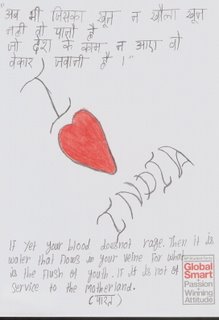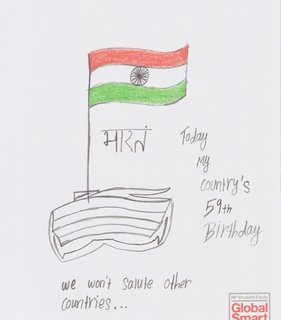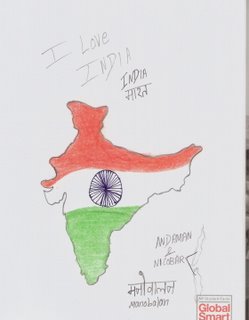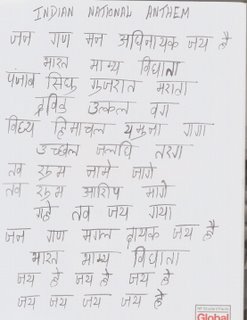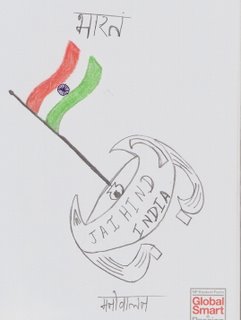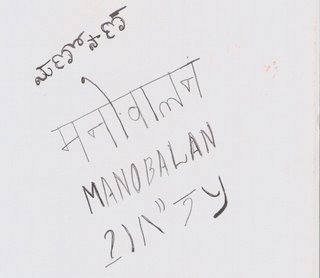Saturday, August 12, 2006
Friday, August 11, 2006
AGRA
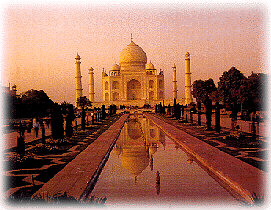
Agra is globally renown as the city of the Taj Mahal. But this royal Mughal city has, in addition to the legendary Taj, many monuments that epitomise the high point of Mughal architecture. In the Mughal period, in the 16th and 17th centuries, Agra was the capital of India. It was here that the founder of the dynasty, Babar, laid out the first formal Persian garden on the banks of the river Yamuna. Here, Akbar, his grandson raised the towering ramparts of the great Red Fort. Within its walls, Jehangir built rose-red palaces, courts and gardens, and Shahajahan embellished it with marble mosques, palaces and pavilions of gem-inlaid white marble.The crowning glory of the city is obviously the Taj, a monument of love and imagination, that represents India to the world.
what to see
The Taj Mahal stands serene and awesome, on a raised marble platform, by the banks of the Yamuna, testifying to the timelessness of art and love. Its pure white marble shimmers silver in the soft moonlight, exudes a shell - pink glow at dawn, and at the close of the day, takes on the tawny, fiery hue of the majestic sun.Shahjahan built the monument in memory of his beloved wife, Mumtaz Mahal, the 'lady of the Taj', who died giving birth to their 14th child. It has been called the most extravagant monument ever built for the sake of love. The construction of the Taj commenced in 1631, and was completed in 1653. Workers were gathered from all over the country and from Central Asia, and about 20,000 people were recruited to translate this wild dream into a reality. The main architect was Isa Khan, who was brought all the way from Shiraz in Iran. After he was deposed and brutally imprisoned in the Agra Fort, by his son Aurangzeb, Shahjahan spent the rest of his life looking wistfully at his wife's final resting place, just across the river. The Taj remains a symbol of eternal love where the heart - broken Shahjahan was subsequently buried, re-united finally with his beloved Mumtaz.
Among the other monuments that Agra takes pride in is the Agra Fort, built by three of the greatest Mughal emperors. The construction of this massive structure began in 1565, under Akbar, and continued till the time of his grandson, Shahjahan. Armed with massive double walls, punctuated by four gateways, the fort houses palaces, courts, mosques, baths, gardens and gracious pavilions within its premises. Among the fascinating structures that are to be found within the fort is the red sandstone Jehangiri Mahal built by Akbar for his Hindu queen, Jodhabai, was one of the earliest constructions illustrating the fort's change from a military structure to a palace. The palace is also notable for its smooth blending of Hindu and central Asian architectural styles. The Diwan - i - Am, the Diwan - i - Khas, the Khas Mahal, the Palace of Mirrors, the Pearl mosque, the Nagina Masjid, the Garden of Grapes, and the Fish Pavilion are the other monuments in the fort complex. (more on Taj Mahal)And what else?Fatehpur Sikhri, Itmad-ul-Doulah Tomb, Bharatpur and also,10 km north of Agra lies Akbar's tomb, in Sikandra. Named after the Afghan ruler Sikander Lodi, Sikandra is the final resting place of Emperor Akbar. Akbar began the construction of his own garden mausoleum during his lifetime, a red sandstone structure in a chahar - bagh, or 4 - square formal garden. An impressive marble - inlaid gateway leads to the spacious four - tiered monument which is crowned by a white marble cenotaph and screen. This last was added by Jahangir, who completed the tomb after the demise of his father.Other places to visit include, Mathura and Brindavan. Mathura, on the banks of the river Yamuna, is the birthplace of Krishna, and Brindavan, the land of thousands of shrines and temples, which still echoes with stories and songs that recount the exploits of this charming God.
How to Get to Agra
By air: Agra is on the popular regular tourist route Delhi/Agra/Khajuraho/Varanasi and return. Flights connect Agra to Delhi, Khajuraho and Varanasi.By rail: Agra lies on the Delhi to Mumbai broad - gauge railway line. Express trains from Delhi, Mumbai, Calcutta, and Chennai halt at Agra.By road: Agra is connected to Delhi, Rajasthan and other cities of Uttar Pradesh by an excellent bus service.
Where to Stay
The Mughal Sheraton Hotel (Tel : +91 - 562 - 361701, Fax: 361730) boasts of an elegant fort - like architecture and is a good place to stay. Other good hotels include Clarks Shiraz Hotel (Tel : 361421, Fax: 361428), Agra Hotel (Tel : 361223, Fax: 361620) and Taj View Hotel (Tel : 361171-78, Fax: 361179).
Contact
Government of India Tourist Office191, The Mall, Agra 282001Tel: 363377, 363959
CHANDIGARH
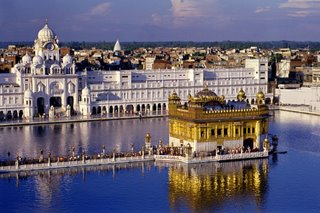
Chandigarh, designed by the French architect Le Corbusier, is the capital of the Indian states of Punjab and Haryana. Though Simla was chosen as temporary headquarters, the need for a permanent capital, resulted in the birth of a new city at the foothills of the Shivalik hills. Chandigarh, then became the new capital of Punjab and Haryana. But the administration of the capital itself was neglected, which was solved, by making it a Union Territory under the Central Government on 1 November 1966.
Covering an area of 56 square kilometres, Chandigarh is the first `planned' city of India. The city has neatly laid out roads and parks, buildings ranging against mountain peaks, boulevards and streets lined by endless rows of trees and shrubs. The city is named after the Goddess Chandi Devi, whose white - domed temple stands on the slope of a hill in the north east of Chandigarh, on the edge of the Shivalik hills. Spread over an area of 114 sq. kms, it is a modern city, built in 47 sectors (excluding the unlucky number 13). Each sector consists of market places and shopping centers. All the sectors are interconnected by State Transport buses, auto-rickshaws and taxis. This city has its population drawn from every community and region in India,and ranks second in literacy among the country's states and union territories.
Chandigarh has about 15 medium and large scale industrial units. These include soft drinks, electric meters, antibiotics, electronic components and equipment, bio-medical equipment, tractor parts, cement pipes and tiles, and washing machines.
What to see
Chandigarh, with all its charms, is literally a treasure - trove for the travel - buff. The Rock garden, a famous tourist spot, is an architectural wonder, covering an area of 6 acres. It was built by Nekchand Saini, with multicoloured pieces of stones and other discarded objects. The Sukhna Lake is an artificial lake, spread over an area of 3 sq. kms. Boating facilities are available here, and walking around the perimeter of the lake is a very refreshing experience. The Museum-cum-Art Gallery is another marvellous place to see. It houses an extensive range of paintings and sculptures by contemporary Indian artists, as well as a collection of old Indian miniatures of the Mughal, Kangra and Rajasthani school.
In sector 16, is Asia's largest rose garden, Zakir Gulab Bagh, spread out over 30 acres of land, boasting of 50,000 rose-trees of 1600 different species!! The Secretariat and High Court buildings, located at sector 1, are veritable proofs of the architectural expertise of Le Corbusier. One can enjoy an excellent view of the city from the roof of the Secretariat. The High Court has a double roof, which provides protection from the sun. What is peculiar is its shape, which resembles the shell of an enormous tortoise!! The Super Market or shopping centre is at sector 17 . Other places of interest include the State Library, Shanti Kunj, Moonlight Garden, Bougainvillea Garden, Bidhan Sabha and University - each a fine specimen of modern art.
How to get there
Chandigarh is 248 kilometres from Delhi and can be reached by bus or train.While visiting Chandigarh, one is reminded of Pandit Jawaharlal Nehru's words, delivered in 1952, "Let this be a new town, symbolic of the freedom of India, unfettered by the traditions of the past - an expression of the nation's faith in the future."
indian tourism
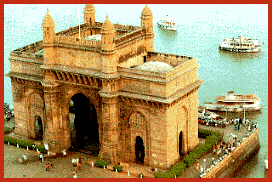
Mumbai (Bombay)
Mumbai, the capital of Maharashtra, is the fastest moving, most affluent and industrialised city in India. Mumbai is part of India's beautiful west coast, that runs down from Gujarat, through Mumbai to Goa, Karnataka and Kerala. The city has a natural harbour, which was developed by the British. It is one of the most busy ports of India, handling approximately 40 percent of India's maritime trade.
Mumbai (till recently known as 'Bombay'), derives its name from the local deity Mumba Devi, whose temple is still there. The Portuguese predecessors of the British preferred to think of the name as Bom Baim, the Good Bay. Mumbai is a group of seven islands which are today known as Colaba, Mahim, Mazgaon, Parel, Worli, Girgaun and Dongri. Large expanses of open sea have been filled in, and tidal swamps have been reclaimed for furthering the land area. These reclaimed areas include Churchgate and Nariman Point.
Mumbai is home to people of all Indian creeds and cultures. It is a fascinating city, throbbing with life, and, for many people, the gateway to India.
What to See
Gateway of India, the principal landmark of Mumbai, was the principal port when the visitors came to India by ship. The gateway was conceived, following the visit of King George V to India in 1911, and was officially opened in 1924. Its architecture is akin to the conventional Arch of Triumph, with elements derived from Muslim styles of 16th century Gujarat. Near the gateway is the Colaba Causeway, which extends to the end of Colaba promontory, the southern end of Mumbai Island. Sassoon dock is always interesting to visit at dawn, when the fishing boats come in and unload their catch.
The area north of Colaba is known as Mumbai Fort, since the old fort was once located here. There are a lot of impressive buildings from Mumbai's golden period here. St. Johns church, dedicated to the soldiers, who laid down their lives in the Sindh campaign of 1838, and the first Afghan war of 1843, is also worth a visit. The Prince of Wales Museum, built to commemorate King George's V visit to India, was opened in 1923. It is modelled on the Indo - Saracenic design, and has sections for art and paintings, archaeology, and natural history. The Jehangir Art Gallery is within the compound of the Museum, and displays paintings of modern Indian artists. Flora Fountain is also nearby, and is the business centre of India, housing many of the major banks and offices. It was erected in 1869 in honour of Sir Bartle Frere, who was governor of Mumbai from 1862-67. Close to the fountain is the Cathedral of St. Thomas begun by Gerald Aungier in 1672, but formally opened in 1718.
Victoria TerminusOne of the most popular promenades of Mumbai is the Marine Drive, built on land reclaimed during 1920, and runs along the shoreline of Back bay, starting at Nariman point, and sweeping around by Chowpatty beach upto Malabar hills. Chowpatty beach is one of Mumbai's famous beaches, and is a popular spot for people seeking evening outs. It is also a scene for the vibrant annual Ganesh Chaturthi festival. A major landmark of this vibrant city is the VT or Victoria Terminus which was designed in Italian Gothic style by F. W. Stevens. The first train to steam out of Mumbai was from here to Thane in 1853.
Taraporewala Aquarium is also on Marine drive, and has both fresh water and saltwater fishes. On top of the Malabar hills are the Hanging Gardens and Kamala Nehru Park, which offer superb views over Mumbai. Some distance away from Malabar Hills is Mahalaxmi Temple, the oldest temple in Mumbai, dedicated to the Goddess of Wealth. Haji Ali tomb and mosque is located nearby, and can be reached by a long causeway, which can be crossed at low tide. Other attractions of Mumbai include the Juhu beach and the Nehru Planetarium.
Around Mumbai
Places which you should visit when in Mumbai are the Elephanta islands, about 10 km northeast of Apollo Bunder, or Gateway of India, Krishnagiri Upavan National Park, Kanheri caves (42 km from Mumbai), Manori beach (40 km), Montepezir and Jogeshwari Caves and Bassein, which separates Mumbai city from the mainland, and was a Portuguese fortified city from 1534 to 1739.
When to Visit
Mumbai can be visited any time of the year, though the hot and humid months of June, July and August are best avoided.
How to Get ThereAir:
There is an extensive network of flights from Mumbai's Sahar (International) and Santa Cruz (Domestic) airports. International flights connect it to all the major cities of the world. There are domestic flights to all the major cities of the country.Train: Mumbai has trains connecting it to all the major cities of the country. Intra city trains in Mumbai are very good, and are the fastest and cheapest way to move around in Mumbai.Road: Mumbai is well connected to all the cities of Maharashtra by bus. Intra city bus services are also very good.
Where to Stay
The premier hotels in the south of the city, are Taj Mahal Hotel and Taj Mahal Intercontinental (Tel: +91-22-2023366) near the Gateway of India, Ambassador Hotel (Tel: 2040004, Fax: 2040004), Ritz Hotel (Tel: 220141), Oberoi Towers (Tel: 2024343) and Hotel President (Tel: 2150808).Near the airport there is the Centaur Hotel (Tel: +91-22-61126660), Hotel Airport Plaza (Tel: 6123390), Hotel Airport International (Tel: 6122883) and Leela Kempinski (Tel: 6363636, Fax: 8360606).
Along Juhu beach, the good hotels include, Hotel Sun-n-sand (Tel: +91-22-6201811), Hotel Sea Princess (Tel: 6122661), Holiday Inn (Tel: 6204444) and Ramada Inn Palm (Tel: 6112323).
Contact
Government of India Tourist Office123 Maharishi Karve Road, Churchgate, Mumbai (Tel: +91-22-291585)Extension Office atInternational airport (Tel: 6325331) and domestic terminal (Tel: 6149200)Maharashtra Tourism Development CorporationCDO Hutments, Madame Cama Road, Mumbai
